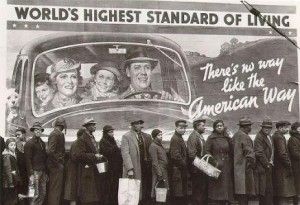Brown Budget Based on Phantom Jobs?
By WAYNE LUSVARDI
Gov. Jerry Brown’s May 2011 Revised State Budget is based on a rosy assumption of an economic and jobs recovery over the next four years that will result in 7.3 percent more tax revenues per year. But, is Gov. Brown’s budget revenue projection based on phantom jobs recovery data?
In an article the May 16 issue of the Wall Street Journal, “Why the Job Market Feels So Dismal,” Professor Edward P. Lazear of the Stanford School of Business and the Hoover Institution points out that the reported national increase in jobs from 2009 to 2011 is a statistical illusion. It mostly comes from a decline in layoffs, not a real increase in new jobs.
For the last three months, the United States has reported that there have been 200,000 new jobs created each month. But what has been reported as new jobs is merely the difference between the number of people leaving jobs for other jobs and the number of people hired into the jobs that others left. This is called turnover or “churn.”
Every year even in an economic recession an employer gains and loses employees no matter if there are no layoffs. People retire, find better jobs, move to a job closer to home, etc. The new hires taking these positions are not taking newly created jobs, but jobs that previously existed. Job churning creates no new jobs.
If layoffs decline or flatten out in a recession, it may create an illusion of “job growth” because “new hires” can be backfilling an increasing number of turnover positions. This sort of statistical illusion is to be expected as the Baby Boomers retire and there is a rise in existing job replacements, along with a flattening of layoffs, creating a rise in phantom “new jobs.”
As Professor Lazear puts it:
First, the increase in job growth that occurred over the past two years results from a decline in the number of layoffs, not from increased hiring. In February 2009, a month during which the labor market lost more than 700,000 jobs, employers hired four million workers. In March 2011, employers hired four million workers. The number of hires is the same today as it was when we were shedding jobs at record rates.
We added jobs because hires exceeded separations, not because hiring increased. There were 4.7 million separations in February 2009. In March 2011 that number had fallen to 3.8 million. The fall in separations reflects a decline in layoffs, which went from 2.5 million per month in February 2009 to 1.6 million per month in March 2011.
This doesn’t mean there have been entirely no new jobs created nationally. As Lazear reports:
One small piece of good news is that the just-released April data showed hires up about 2 percent over last year’s average and 12 percent above the low reached in January 2010.
New Job Growth in CA?
But this raises the question whether there has been any substantial new job growth in California. Apparently, there is no data available on new hires and job separations for California. Nonetheless, the following proxy data indicatethat there may be a phantom California jobs recovery.
The Bureau of Labor Statistics report for California for April 2011 indicates that layoffs have leveled off, and if they continue at the same pace will be back to pre-2008 levels as shown below:
CALIFORNIA LAYOFFS (source: U.S. Bureau of Labor Statistics)
| California Layoffs (source: Bureau of Labor Statistics) | |
| Year | Number of Layoffs |
| 2007 | 4,130,000 |
| 2008 | 5,430,000 |
| 2009 | 6,377,000 |
| 2010 | 5,110,000 |
| 2011 (four months) | 1,457,000 ( yearly est. 4,171,000) |
.
The Bureau of Labor Statistics’ April 2011 report for California does provide data for job “hires” and “separations” by region rather than by state. And the pattern of jobs separations exceeding hirings observed by Professor Lazear for the U.S. also holds true for the Western U.S., as shown below:
JOB HIRES AND SEPARATIONS IN WESTERN U.S. (BLS, April 2011)
| JOB HIRES (numbers in thousands 1,000’s) | |||||||
| 3/2010 | 10/2010 | 11/2010 | 12/2010 | 1/2011 | 2/1011 | 3/2011 | TOTAL |
| 913 | 839 | 883 | 806 | 939 | 862 | 830 | 6,072 |
| Rate | 2.9% | 3.1% | 2.8% | 3.3% | 3.3% | 3.0% | |
| JOB SEPARATIONS (numbers in thousands – 1,000’s) | |||||||
| 924 | 782 | 829 | 759 | 817 | 857 | 866 | 5,834 |
| 3.2% | 2.7% | 2.9% | 2.7% | 2.9% | 2.9% | 3.0% | |
.
Phantom Job Growth
We can reasonably infer from the proxy regional data shown above that California also has higher job separations than job hirings. This is the same pattern noted by Prof. Lazear to reflect growth in job turnover, not in new job creation.
This would call into question newspaper and broadcast media reports of a California jobs recovery, such as the following:
* “200,000 Net Jobs Added,” Associated Press, reported by Huffington Post, Mar. 25, 2011
* “California Adds Nearly 100,000 Jobs in Feb. as Hiring Accelerates,” L.A. Times, Mar, 26, 2011
And this would call into question whether Gov. Jerry Brown’s May Revise of the State Budget is based on a forecast of a phantom jobs recovery.
Phantom Jobs + Taxes = Busted Budget
Gov. Brown’s May Revise budget projection of rising revenues is based on a growing number of private sector jobs, together with the continuation of the 1 percent premium on the state sales rate and higher vehicle license fees. But you can’t create new jobs or a balanced state budget out of phantom statistical illusions of new jobs and higher taxes.
According to Prof. Lazear, the best way to create new job growth is to lower taxes, especially on capital investments, avoid burdensome regulation wherever possible, and to “open markets” up to create profitable investment that will result in a growing jobs market.
But Gov. Brown and the Democratic majority in the Legislature want to do the opposite.
Related Articles
Cal recovery lags USA
JUNE 7, 2010 By JOHN SEILER California’s economy is recovering, but more slowly than that of the rest of America,
Brown-GOP Negotiations Revealed
Satire alert MARCH 14, 2011 By DAVE ROBERTS Five Republican Senate mavericks have been negotiating with Gov. Jerry Brown in
Schools case fuels Kashkari campaign
The historic Vergara school liberty ruling has handed a campaign issue to Neel Kashkari, Republican candidate for California Governor. In




